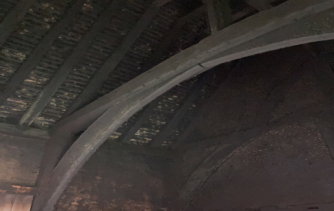Elmscroft, Charlton Lane
Many of us have walked or driven past Elmscroft, up until recently the home of Dandelion Time. Many of us have visited on Open Days and Summer Fayres. Some of us have also enjoyed Shakespeare in the garden.
I expect you saw a large Queen Ann farm house. With barns, ragstone farm buildings and farm cottages. The house has the typical windows and main door of a Queen Ann style house.
But it is not what it seems.
The house was originally a medieval Wealden Hall House. It would have looked similar to the house pictured below.
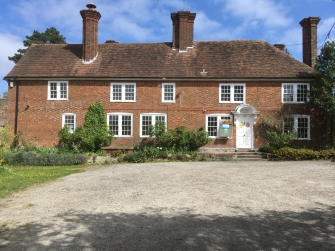
Built in the 1400’s, the centre part of the House would have been the hall and double height, with a vent in the roof to let the smoke out from the fire lit in the middle of the hall. This would have been for heating and cooking.
At one end there would have been 2 parlours and at the other a kitchen and pantry.
There would have been bedrooms above these rooms. There was no access from one set of upper rooms to the other.
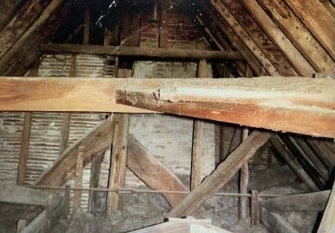
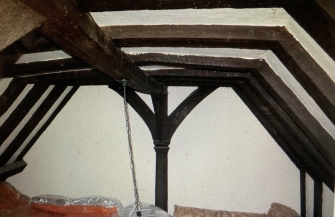
Many of the original roof timbers can still be seen. Some in situ and others reused when the house was enlarged, modernised etc over the centuries.
The vestigial lower part of the crown post is visible at the north end of the original house.
You can also see that many old timbers have been reused, at a later date.
This is the original crown post from the south end of the original house.
The house would have been built by a yeoman farmer, who would have owned and farmed the land round it. A yeoman was a free man. Nobody’s servant but also not gentry. He would have employed local men to help him work the land. The farm labourers would probably have been housed and employed throughout the year. When no actual farming was being done, they would lay hedges and clear ditches.
In the 1500’s the house was “modernised”. An inglenook fireplace with a proper chimney was installed. This fire place is still inexistence in the entrance hall. Over the years it has been altered many times but the carved wooden beam over the fireplace is thought to be original, but the back and side walls have been altered (modernised by the Victorians). This meant the building of a chimney.
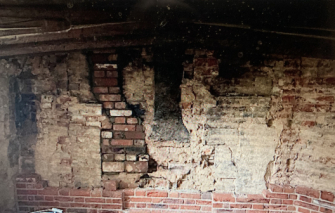
Look at the photo of the house today. The central stack serves this fireplace. However, the chimney has probably been replaced, when other adaptations were done. Round about the same time a floor was put in joining up the upper rooms.
As the renovations have progressed, some of the original external walls of the Hall House have been exposed. The corner post and part of the original east wall were uncovered, stabilised and left to indicate the houses age. Everything to the left of the old wall is 18th Century.
The room above the hall has no ceiling and goes up to the roof. This may have always been the case. The ceiling in the hall being of a later date. This would have been the centre of the old Hall house where the fire would have been in the middle of the hall and the smoke would have risen up to the roof. A small maids room has been found in the attic, which appears to have been accessed by a ladder.
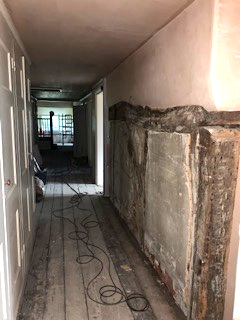
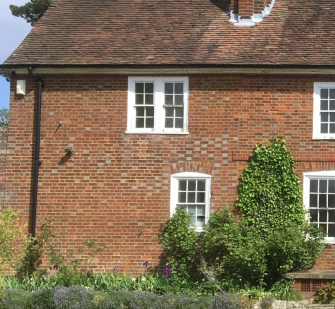
No records have been found of who originally lived in the house... we are still looking! However, in 1746 a Mary Charlton was born and baptised in West Farleigh. Her father Thomas Charlton was born in Linton and probably moved to Elmscroft to start his family.
It seems as if Thomas Charlton, may have initiated the encasement of the house and the extensions. There is an extension to the back of the house built at the same time as the northern extension.
Looking at the close up of the house below, you can see below the chimney stack, where the extension was added to the brick encasement.
The plan below shows the later additions to the house.
- The area outlined in red is the original house, which was built in the 15th Century.
- The area 1.5 is unusual for a Hall House. They were usually simple rectangular buildings.
- The area outlines in blue is the part that ws added in the 18th Century, possibly by Thomas Charlton.
- The bay outlined in yellow was added in the 19th Century to give this room a smart Georgian appearance. The room still has a georgian feel, but some of the artefacts are just in a "georgian style". Never the less, a very smart room!
- The area marked in green was added in the 20th Century.
It is typical that the house has been added to and altered over the year. New owners wanting to use the house for different things, or create a different impression.
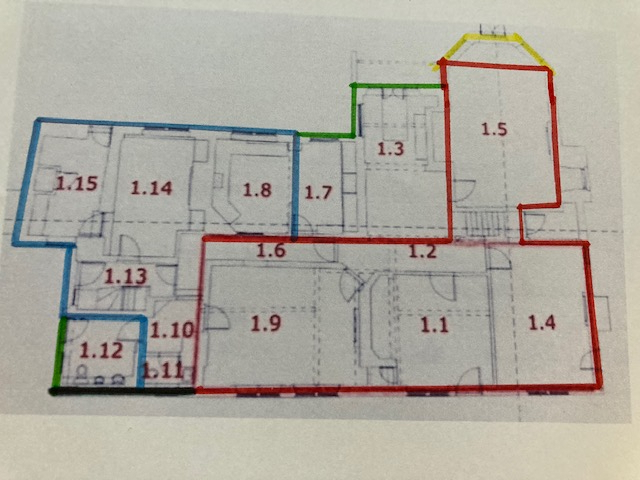
Where the garages are, in the court yard shared by Dandelion, There used to be a least one small two up two down cottage. Phyllis Smitherman, who was an Evergreen, told us that she live there with her parents. Who both worked for the Fletchers. Her brothers had one bedroom and she shared a bedroom with her parents. When she left school, she went into service at Elmscroft. She can recall looking out of the windows of the big house and waving to her future husband, who was working as an Agricultural labourer in the fields opposite. She lived in the village all her life.
The current owners, William and Alex Norman, have renovated the whole house, to preserve its history and to make it suitable for 21st Century living.
We hope they have many happy years there.
A 'look-a-like' Elmscroft at Weald and Downland Museam
On a visit to the Weald and Downland Museum, I came across a 15C Hall House, as it would have been when first built. The similarities to Elmscroft were striking.
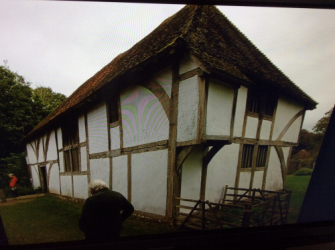
An "en suite" had been added to the side wall. This appeared to be a cupboard with a shelf. On closer inspection the shelf had a hole cut in it, directly above the midden!
The corner post with the wood and plaster is very similar to that, which was uncovered in Elmscroft. See earlier article below.
The King post was also very similar.
The photo below shows how the master bedroom would have looked.
A four poster with curtains to keep out the draught. No glass in the windows, just shutters.
Note the truckle bed under the main bed. Was this for the children or the maid?
The photo below shows the hall, going up to the roof, where there would have been a fire burning in the middle of the room, for heating and cooking. Note the smoke blackened roof.
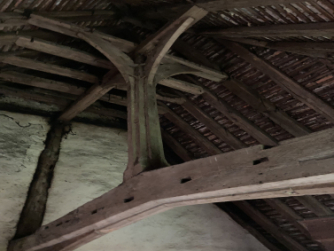
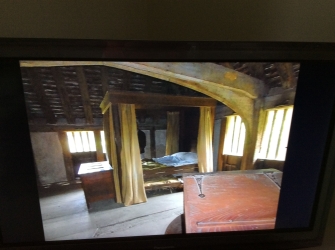
The room directly above the hall in Elmscroft, has no ceiling and goes straight up to the roof. A previous occupant commented that the roof looked sooty and wondered if there had been a fire in this room which had destroyed the ceiling! There probably has never been a ceiling and the soot was many centuries old!
What else will be discover? We would love to find out who lived there, over the centuries. We may need to backwards with this research!
